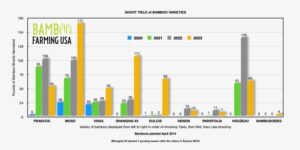2023
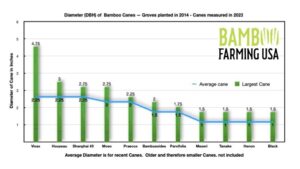
Compare Varieties
Observations: Each spring I harvest bamboo shoots to sell and to eat. I work with the following varieties of Phyllostachys.
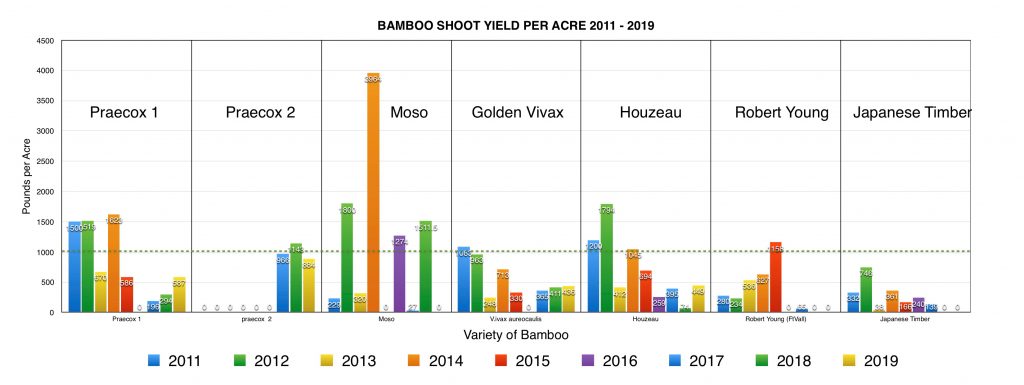
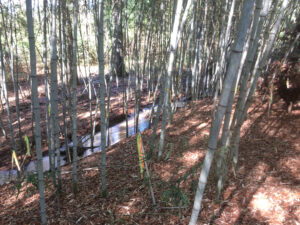
Henon: I work with two groves; one in Fort Valley and one in Bonaire. The grove in Fort Valley does not produce because it is located where the soil does not warm up until shooting time is past. In 2019 the grove flowered and died. The grove in Bonaire has a disease and while this henon does send up a few new canes each spring, they die in early summer. I gave up harvesting shoots in 2016. I thought it was a root disease; county agents surmised it was a leaf disease. We do not know.
Praecox – Early Bamboo. 2011 and 2012 were good years. In 2013, a cold spring reduced yield in Praecox and all other varieties except Robert Young. In 2014, yield came back and increased a bit.
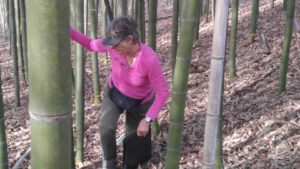 Then in 2015 Production fell. I encouraged the grove to expand to the south by cutting away a competing bamboo with small canes. By 2017, the expansion had created a new research plot: Praecox 2. Why did production fall off in Praecox 1 from 2015 to 2019? One problem was that the nursery just up hill from Praecox 1 drained water into the plot. One third of the plot was too wet for rhizomes to survive. The nursery is now defunct so irrigation water is not killing the rhizomes in one third of the research plot. Praecox 1 may be returning to respectable yearly yields according to the slope of the graph of yield in 2017, 18, and 19.
Then in 2015 Production fell. I encouraged the grove to expand to the south by cutting away a competing bamboo with small canes. By 2017, the expansion had created a new research plot: Praecox 2. Why did production fall off in Praecox 1 from 2015 to 2019? One problem was that the nursery just up hill from Praecox 1 drained water into the plot. One third of the plot was too wet for rhizomes to survive. The nursery is now defunct so irrigation water is not killing the rhizomes in one third of the research plot. Praecox 1 may be returning to respectable yearly yields according to the slope of the graph of yield in 2017, 18, and 19.
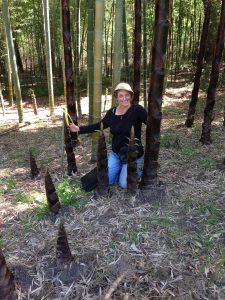
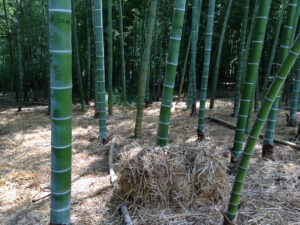 Moso: See above.
Moso: See above.
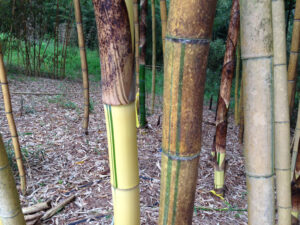 Golden Vivax: Much the same yearly pattern as Praecox 1. I think that the continual harvesting that I am doing requires me to fertilize and mulch more than I have been doing.
Golden Vivax: Much the same yearly pattern as Praecox 1. I think that the continual harvesting that I am doing requires me to fertilize and mulch more than I have been doing.
Golden vivax is less vigorous than the standard green vivax. It will revert to the green. I rogue out the green canes within the research plot. I usually let the green ones outside the plot remain.
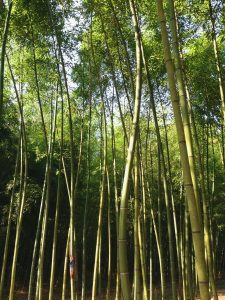
Houzeau: Also a similar pattern to Praecox 1. However, Houzeau’s pattern is different because its low yield in 2016 to 2019 is due to disease. Houzeau is across the dirt road from the sick Henon. In 2015, Houzeau’s yield dropped from 1045 pounds to 695 pounds per acre. A third less productive. I counted two canes with top die-back and 10 canes with necrotic spots at the base of the canes.
It looked to me that the Houzeau had caught the same disease that devastates the henon across the farm road. Field Notes 3/26/2015 “leaves turning yellow”; 6/30/2015 “cleared 20 canes cut into 6′ lengths”. These were cleared because they were dead or dying. 9/9/2015 “Leaves look a bit spotted.” 8/25/ 2016 “Lots of dead poles – drought? disease?” 11/30/2016: “12 or 13 canes dead, rest look OK”. 2/7/2017: “15 canes with dead tops; 3 dead canes”, “a lot of the 2016 canes have dead tops and live leaves at lowest level.” 2/20/2018: “18 dead tops – Far too much light – Soil seems dead & dry”.
6/19/2019 Pulled 16 dead poles from Houzeau“. 7/5/2019 Chipped piled poles of poles onto Houzeau; 7/24/2019 llama poop. 7/31/2019 “Darryl cut down all dead poles; poles are dying from top down; some have black spots, many do not”. By 9/11/2019 Houzeau has llama poop plus bamboo charcoal.
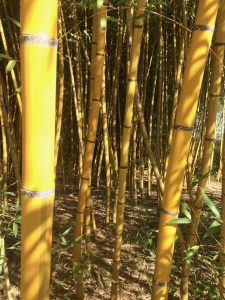 Robert Young: The yield pattern of Robert Young from 2011 to 2015 is different from the other bamboos. Robert Young increased yield in 2012 when all other bamboos decreased. Spring was cold. However, Robert Young is a late shooter so avoided the worst of the unusual cold weather. It is located in a warm site where the sun hits directly from sunup to sundown. Also for the first two years, Robert Young was the bamboo that I was able to irrigate. It is located across from a well house so I could run a hose and a sprinkler in the grove. In years 2016 to 2019, I gave up working with Robert Young because the power company cut some of it down for being too close to power lines. I do harvest shoots but the plot itself is partially cut down by the power company, so I don’t collect data.
Robert Young: The yield pattern of Robert Young from 2011 to 2015 is different from the other bamboos. Robert Young increased yield in 2012 when all other bamboos decreased. Spring was cold. However, Robert Young is a late shooter so avoided the worst of the unusual cold weather. It is located in a warm site where the sun hits directly from sunup to sundown. Also for the first two years, Robert Young was the bamboo that I was able to irrigate. It is located across from a well house so I could run a hose and a sprinkler in the grove. In years 2016 to 2019, I gave up working with Robert Young because the power company cut some of it down for being too close to power lines. I do harvest shoots but the plot itself is partially cut down by the power company, so I don’t collect data.
Japanese Timber: I have two theories about the poor productivity of my Japanese timber. One theory is that my research plot for Japanese timber is located lower on the slope and deeper in the woods than the nearby moso and henon. It is in a cooler wetter location. Japanese timber likes heat. This theory accords with the fact that up by the farm road, there is a pile of dirt. The Japanese timber grows vigorously there. It invades the moso plot and I cut it out each year.
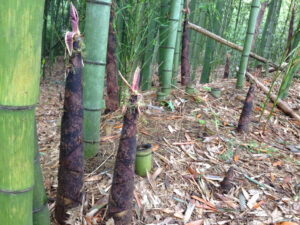 The second theory is that Japanese Timber takes 20 years to size up according to Wade Bennett of Rock Ridge Nursery in Washington State. However, this Japanese timber was planted in 1998 or 1999. It has had time to size up.
The second theory is that Japanese Timber takes 20 years to size up according to Wade Bennett of Rock Ridge Nursery in Washington State. However, this Japanese timber was planted in 1998 or 1999. It has had time to size up.
Conclusions:
Expectations: People say of bamboo “watch out; it will take over” (vigorous) and “you can’t kill it” (tough). In fact, it is a crop with specific requirements: warm location, ample humidity, ample irrigation during growing season, fertilizer, ample organic fertilizer, mulch, yearly thinning, no competition from weeds especially vines and grasses.
Location: Plant bamboo where the soil warms quickly in spring. Most bamboos will not grow in saturated soil.
Disease: yes, bamboo can get debilitating disease. And extension agents can not identify the disease(s).
Moisture: Rhizomes rot in saturated soil.
Time and Money: In 2014, I planted my own bamboo in Hawkinsville Georgia. I spent less time and resources caring for the mature bamboos from which I derived my data from 2014 to the present.
